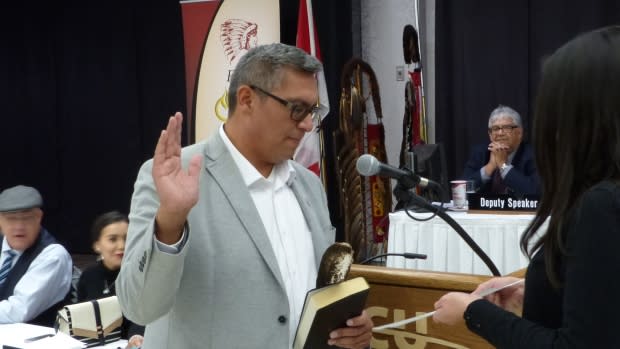FSIN says opioid crisis 'an issue of justice and public safety,' calls for funding to help First Nations
Chief Calvin Straightnose was driving from Keeseekoose First Nation to Saskatoon Tuesday for a news conference hosted by the Federation of Sovereign Indigenous Nations — and he was worried.
"What am I going to say?" he asked himself.
"My family's affected big time by this crisis."
The news conference was held by Federation of Sovereign Indigenous Nations Vice-Chief David Pratt to call for funding to help First Nations deal with the opioid crisis within their communities.
Indigenous people who live on reserve and in urban communities are disproportionately affected by HIV and hepatitis C. Their communities have been hit hard by crystal meth and opiate addiction.
"My nephew, he's lonely for his mother and his dad because they both overdosed," said Straightnose.
"Nobody wants to address it or hear about it, but it's time we're heard. When do we start healing ourselves? We need a place to heal, we need a place to do things."
The chiefs at the Tuesday conference spoke at length about the needs of their communities, both funding and otherwise.
Culturally based treatment needed
In addition to overdoses, full treatment centres, and mental health crises, the chiefs are concerned about the violence and crime that have followed opiates into their communities.
"Our First Nations community members have been assaulted by family members or friends addicted to crystal meth and opioids. Now gangs are coming into our communities, selling drugs," said Pratt.
"Now it's become an issue of justice and public safety."

The chiefs pointed towards the Saulteaux Healing and Wellness Centre in Kamsack, Sask., as a successful culturally based model that could be built on.
But it needs to be built from the grassroots — the people living in the community, they said.
"The funders come in and say, 'Oh, this is the programming, this is what we can fund,' and it's not working," said Muskowekwan First Nation Chief Reginald Bellerose.
There should be an immediate intake from the emergency wards right to the treatment centre. - FSIN Vice-Chief David Pratt
"So we have to break the status quo. We have our own resource people who can do that … but they're not allowed into the addiction system."
Bellerose told reporters than often, when an initiative is First Nation-led, there is little funding available.
"Ministers don't get the phone calls. The chiefs and the FSIN get the phone calls," said Pratt.
He wants the federal government to redirect resources to the Saskatchewan region, to focus specifically on Indigenous people in the province dealing with opioid and crystal meth addiction.
Waiting lists, revolving door at treatment centres
While the Saulteaux Healing Centre has been successful on many fronts, more beds are needed, say the chiefs.
Further supports are also needed post-treatment.
"It's become a revolving door," said Pratt.
People come into detox, receive treatment, and recover. Post-treatment, sometimes they find themselves back in the same situation they escaped.
Some people aren't even able to make it to treatment.
"There should be an immediate intake from the emergency wards right to the treatment centre," said Pratt.
"It's not just an issue where people are overdosing."
There are some treatment centres that take a different approach.
"Montreal Lake [Cree Nation] has a nice model where they have a treatment facility not based on the 28-day model," said AIDS Saskatoon executive directorJason Mercredi.
We're just starting the first wave of the opioid crisis. - Jason Mercredi, AIDS Saskatoon
"[The 28-day model] just doesn't work. It's based on American insurance coverage, not based on best practice."
Eighty-two per cent of the people Mercredi works with are Indigenous. He says he, too, has heard a desire for culturally based, holistic healing services.
"We're just starting the first wave of the opioid crisis," he said, pointing to the experiences of B.C. and Ontario — regions that were hit earlier than Saskatchewan.
Kits containing naloxone — used to treat opioid overdoses — weren't as readily available in those provinces as they are now in Saskatchewan.
"You should be able to get a naloxone kit anywhere in Saskatchewan with minimal effort," he said — including on reserve.
The chiefs who met Tuesday recognize the need for naloxone, but hope to have a more holistic solution that reduces the number of people needing an antidote in the first place.

